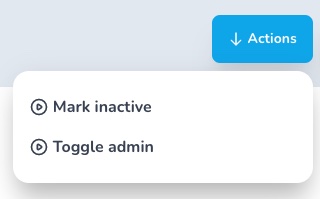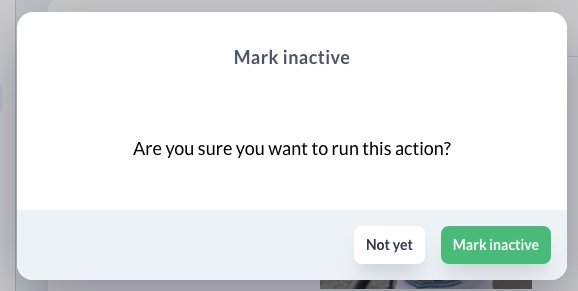# Actions
Avo actions allow you to perform specific tasks on one or more of your records. For example, you might want to mark a user as active/inactive and optionally send a message that may be customized by the person that wants to run the action.
Once you attach an action to a resource using the actions method it will appear in the Actions dropdown.

# Overview
You generate one running bin/rails generate avo:action toggle_active creating an action configuration file.
class ToggleActive < Avo::BaseAction self.name = 'Toggle active' field :notify_user, as: :boolean, default: true field :message, as: :text, default: 'Your account has been marked as inactive.' def handle(**args) models, fields, current_user, resource = args.values_at(:models, :fields, :current_user, :resource) models.each do |model| if model.active model.update active: false else model.update active: true end # Optionally you may send a notification with the message to that user from inside the action UserMailer.with(user: model).toggle_active(fields[:message]).deliver_later end succeed 'Perfect!' end endCopied!
You may add fields to the action just as you do it in a resource. Adding fields is optional. You may have actions that don't have any fields attached.
field :notify_user, as: :boolean field :message, as: :textarea, default: 'Your account has been marked as inactive.'Copied!

The handle method is where the magic happens. This is where you put your action logic. In this method, you will have access to the selected models (if there's only one it will be automatically wrapped in an array) and, the values passed to the fields.
def handle(**args) models, fields = args.values_at(:models, :fields) models.each do |model| if model.active model.update active: false else model.update active: true end # Optionally you may send a notification with the message to that user. UserMailer.with(user: model).toggle_active(fields[:message]).deliver_later end succeed 'Perfect!' endCopied!
# Registering actions
To add an action to one of your resources, you need to declare it on the resource using the action method.
class UserResource < Avo::BaseResource self.title = :name self.search = [:id, :first_name, :last_name] field :id, as: :id # other fields action ToggleActive endCopied!
# Action responses
After an action runs, you may use a few methods to respond to the user. You may respond with just a message or with a message and an action.
The default response is to reload the page and show the Action ran successfully message.
# Message responses
You will have two message response methods at your disposal succeed and fail. These will render out green or red alerts to the user.
def handle(**args) models = args[:models] models.each do |model| if model.admin? fail "Can't mark inactive! The user is an admin." else model.update active: false succeed "Done! User marked as inactive!" end end endCopied!


# Response types
After you notify the user about what happened through a message, you may want to execute an action like reload (default action) or redirect_to. You may use message and action responses together.
def handle(**args) models = args[:models] models.each do |model| if model.admin? fail "Can't mark inactive! The user is an admin." else model.update active: false succeed "Done! User marked as inactive!" end end reload endCopied!
The available action responses are:
# reload
When you use reload, a full-page reload will be triggered.
def handle(**args) models = args[:models] models.each do |project| project.update active: false end succeed 'Done!' reload endCopied!
# redirect_to
redirect_to will execute a redirect to a new path of your app.
def handle(**args) models = args[:models] models.each do |project| project.update active: false end succeed 'Done!' redirect_to '/avo/resources/users' endCopied!
# download
download will start a file download to your specified path and filename.
You need to set may_download_file to true for the download response to work like below. That's required because we can't respond with a file download (send_data) when making a Turbo request.
If you find another way, please let us know 😅.
class DownloadFile < Avo::BaseAction self.name = "Download file" self.may_download_file = true def handle(**args) models = args[:models] models.each do |project| project.update active: false report_data = project.generate_report_data report_filename = project.report_filename end succeed 'Done!' if report_data.present? and report_filename.present? download report_data, report_filename end end endCopied!
# Customization
class TogglePublished < Avo::BaseAction self.name = 'Mark inactive' self.message = 'Are you sure you want to mark this user as inactive?' self.confirm_button_label = 'Mark inactive' self.cancel_button_label = 'Not yet' self.no_confirmation = trueCopied!
# Customize the message
You may update the self.message class attribute to customize the message if there are no fields present.
# Customize the buttons
You may customize the labels for the action buttons using confirm_button_label and cancel_button_label.

# No confirmation actions
By default when you run an action you will be prompted by a confirmation modal. If you don't want to show the confirmation modal, pass in the self.no_confirmation = true class attribute. This will execute the action without showing the modal at all.
# Standalone actions
You may need to run actions that are not necessarily tied to a model. Standalone actions help you do just that. Add self.standalone to an existing action to do that or generate a new one using the --standalone option (bin/rails generate avo:action global_action --standalone).
class DummyAction < Avo::BaseAction self.name = "Dummy action" self.standalone = true def handle(**args) fields, current_user, resource = args.values_at(:fields, :current_user, :resource) # Do something here succeed 'Yup' end endCopied!
# Hide actions on specific screens
You may want to hide specific actions on specific screens, like a standalone action on the Show screen. You can do that using the self.visible attribute.
class DummyAction < Avo::BaseAction self.name = "Dummy action" self.standalone = true self.visible = -> (resource:, view:) { view == :index } def handle(**args) fields, current_user, resource = args.values_at(:fields, :current_user, :resource) # Do something here succeed 'Yup' end endCopied!
